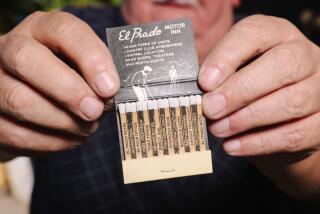Judging a Bookbinder By His Covers
- Share via
Rene Patron, bookbinder, says he doesn’t need publicity and distrusts journalists, having been “the shyest reporter in Paris” before finding the quieter thrill of restoring books. University librarians, commercial dealers and private collectors say the graying but intense Frenchman is one of three or four masters of his craft in Los Angeles.
He practices it in a workshop behind his house in the Hollywood hills, on books that are mostly rare and often old. The jobs range from two hours cleaning a slightly soiled family Bible to two weeks to completely reassemble a precious medieval volume. His efforts have included work on a Latin speller from 16th century Antwerp and an early edition of the “Anatomy of Melancholy,” 17th century England’s famous text of medicine and philosophy.
Arriving for a visit, I tell Patron I’ve just heard a radio show about the disappearance, in our increasingly automated society, of skilled work and how good it feels to see him amid his dozens of tools. He gives a knowing smile. “This is a kind of work that has been done the same way for years and years. The point of what I do,” he adds, “is to give an idea of the book as it was.” Many of the volumes neatly stacked on his shelves and work tables are broken and bruised. The first step is to examine them, weighing the prospect for repair. His touch is almost surgical.
Today’s mail has brought a smallish, coverless, turn-of-the-century San Francisco cookbook. It’s from a new client who heard of him, as most do, by word of mouth. Cookbooks and children’s books often are those most cherished by their owners but, after long use, need much work. “The thing is very fragile,” Patron says, lifting the book from its make-shift cover of brown paper.
“The spine isn’t as bad as it might seem,” he diagnoses. “But I’ll have to reinforce it.” That means cutting a new, relatively light cover of rag-board, a so-called binderboard, then adding paper with an elaborate, colorful design typical of the late 19th century.
The owner wants his book rebound in goatskin. But Patron won’t do it. “Leather and wood would be sturdier but wouldn’t fit the period. Many people these days will overbuild a book, but you don’t want a cover you need a weightlifter to open.”
He leads the way to the back of the shop, an open space bearing traces of the monastic solitude in which books were made and read for centuries. The room holds one kind of large press for griping loose pages while they are sewn, another for compacting them while an adhesive paste dries. Longish brushes stand upright in a jar, along with rolls of leather and finely colored paper.
Nearby stands a tall, narrow glass-covered chest that holds dozens of gilding stamps, screwdriver-sized tools that bulge at the end into multi-shaped metal faces. He uses them to press carefully designed, historically appropriate patterns in gold-leaf onto fresh leather covers.
Patron, 55, was born in Reims. Visiting this country in 1965, wanting a new start after his journalistic fiasco, he heeded a friend who suggested the binding business and returned to France to train. “I had always been a big reader and loved books, so it was right.” After three years of study and an apprenticeship, he was back, opening the shop in Los Angeles in 1972 and “very slowly” building a clientele that gives him about 700 books a year to repair. “People start to trust you,” he says.
“He’s an interesting blend of both a contemporary nature and a traditional one,” said Michael Dawson, whose business, one of the most distinguished antiquarian book stores in Los Angeles, bears his family name. “Some people tend to bind their books very tightly, and it makes them difficult to open and read,” said David Zeidberg, Avery director of the Huntington Library. “Rene binds books in a way where they can open flat and the bindings remain intact.”
Patron recently dropped off for Zeidberg a book about the aristocracy of Verona by one Giovanni Francesco Tinto, published in 1542. “The book was completely in tatters,” Zeidberg said, with subtle excitement. “He’s completely rebound it--that means a lot of sewing and selecting the covers. The covers are the new part. It really looks like new.”
More to Read
Sign up for our Book Club newsletter
Get the latest news, events and more from the Los Angeles Times Book Club, and help us get L.A. reading and talking.
You may occasionally receive promotional content from the Los Angeles Times.







